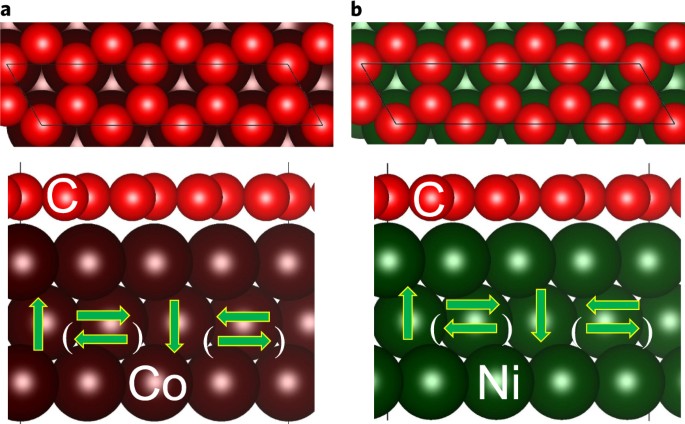
- Select a language for the TTS:
- UK English Female
- UK English Male
- US English Female
- US English Male
- Australian Female
- Australian Male
- Language selected: (auto detect) - EN
Play all audios:
ABSTRACT The possibility of utilizing the rich spin-dependent properties of graphene has attracted much attention in the pursuit of spintronics advances. The promise of high-speed and
low-energy-consumption devices motivates the search for layered structures that stabilize chiral spin textures such as topologically protected skyrmions. Here we demonstrate that chiral spin
textures are induced at graphene/ferromagnetic metal interfaces. Graphene is a weak spin–orbit coupling material and is generally not expected to induce a sufficient Dzyaloshinskii–Moriya
interaction to affect magnetic chirality. We demonstrate that indeed graphene does induce a type of Dzyaloshinskii–Moriya interaction due to the Rashba effect. First-principles calculations
and experiments using spin-polarized electron microscopy show that this graphene-induced Dzyaloshinskii–Moriya interaction can have a similar magnitude to that at interfaces with heavy
metals. This work paves a path towards two-dimensional-material-based spin–orbitronics. Access through your institution Buy or subscribe This is a preview of subscription content, access via
your institution ACCESS OPTIONS Access through your institution Access Nature and 54 other Nature Portfolio journals Get Nature+, our best-value online-access subscription $29.99 / 30 days
cancel any time Learn more Subscribe to this journal Receive 12 print issues and online access $259.00 per year only $21.58 per issue Learn more Buy this article * Purchase on SpringerLink *
Instant access to full article PDF Buy now Prices may be subject to local taxes which are calculated during checkout ADDITIONAL ACCESS OPTIONS: * Log in * Learn about institutional
subscriptions * Read our FAQs * Contact customer support SIMILAR CONTENT BEING VIEWED BY OTHERS LARGE EXCHANGE SPLITTING IN MONOLAYER GRAPHENE MAGNETIZED BY AN ANTIFERROMAGNET Article 10
August 2020 EMBEDDING ATOMIC COBALT INTO GRAPHENE LATTICES TO ACTIVATE ROOM-TEMPERATURE FERROMAGNETISM Article Open access 25 March 2021 SUPERCONDUCTIVITY AND SPIN CANTING IN
SPIN–ORBIT-COUPLED TRILAYER GRAPHENE Article 07 May 2025 REFERENCES * Castro Neto, A. H., Guinea, F., Peres, N. M. R., Novoselov, K. S. & Geim, A. K. The electronic properties of
graphene. _Rev. Mod. Phys._ 81, 109–162 (2009). Article Google Scholar * Han, W., Kawakami, R. K., Gmitra, M. & Fabian, J. Graphene spintronics. _Nat. Nanotech._ 9, 794–807 (2014).
Article Google Scholar * Roche, S. et al. Graphene spintronics: the European Flagship perspective. _2D Mater._ 2, 030202 (2015). Article Google Scholar * Karpan, V. M. et al. Graphite
and graphene as perfect spin filters. _Phys. Rev. Lett._ 99, 176602 (2007). Article Google Scholar * Cobas, E., Friedman, A. L., van't Erve, O. M. J., Robinson, J. T. & Jonker, B.
T. Graphene as a tunnel barrier: Graphene-based magnetic tunnel junctions. _Nano Lett._ 12, 3000–3004 (2012). Article Google Scholar * Bodepudi, S. C., Singh, A. P. & Pramanik, S.
Giant current-perpendicular-to-plane magnetoresistance in multilayer graphene as grown on nickel. _Nano Lett._ 14, 2233–2241 (2014). Article Google Scholar * Han, W. et al. Tunneling spin
injection into single layer graphene. _Phys. Rev. Lett._ 105, 167202 (2010). Article Google Scholar * Dlubak, B. et al. Highly efficient spin transport in epitaxial graphene on SiC. _Nat.
Phys._ 8, 557–561 (2012). Article Google Scholar * Dedkov, Yu. S., Fonin, M., Rüdiger, U. & Laubschat, C. Rashba effect in the graphene/Ni(111) system. _Phys. Rev. Lett._ 100, 107602
(2008). Article Google Scholar * Liu, M.-H., Bundesmann, J. & Richter, K. Spin-dependent Klein tunneling in graphene: Role of Rashba spin–orbit coupling. _Phys. Rev. B_ 85, 085406
(2012). Article Google Scholar * Kane, C. L. & Mele, E. J. Quantum spin Hall effect in graphene. _Phys. Rev. Lett._ 95, 226801 (2005). Article Google Scholar * Vo-Van, C. et al.
Ultrathin epitaxial cobalt films on graphene for spintronic investigations and applications. _New J. Phys._ 12, 103040 (2010). Article Google Scholar * Rougemaille, N. et al. Perpendicular
magnetic anisotropy of cobalt films intercalated under graphene. _Appl. Phys. Lett._ 101, 142403 (2012). Article Google Scholar * Yang, H. X. et al. Anatomy and giant enhancement of the
perpendicular magnetic anisotropy of cobalt–graphene heterostructures. _Nano Lett._ 16, 145–151 (2015). Article Google Scholar * Miron, I. M. et al. Fast current-induced domain-wall motion
controlled by the Rashba effect. _Nat. Mater._ 10, 419–423 (2011). Article Google Scholar * Emori, S., Bauer, U., Ahn, S.-M., Martinez, E. & Beach, S. D. Current-driven dynamics of
chiral ferromagnetic domain walls. _Nat. Mater._ 12, 611–616 (2013). Article Google Scholar * Ryu, K.-S., Thomas, L., Yang, S.-H. & Parkin, S. Chiral spin torque at magnetic domain
walls. _Nat. Nanotech._ 8, 527–533 (2013). Article Google Scholar * Haazen, P. P. J. et al. Domain wall depinning governed by the spin Hall effect. _Nat. Mater._ 12, 299–303 (2013).
Article Google Scholar * Jonietz, F. et al. Spin transfer torques in MnSi at ultralow current densities. _Science_ 330, 1648–1651 (2010). Article Google Scholar * Romming, N. et al.
Writing and deleting single magnetic skyrmions. _Science_ 341, 636–639 (2013). Article Google Scholar * Yu, X. Z. et al. Skyrmion flow near room temperature in an ultralow current density.
_Nat. Commun._ 3, 988 (2012). Article Google Scholar * Iwasaki, J., Mochizuki, M. & Nagaosa, N. Current-induced skyrmions in constricted geometries. _Nat. Nanotech._ 8, 742–747
(2013). Article Google Scholar * Parkin, S. S. P., Hayasi, M. & Thomas, L. Magnetic domain-wall racetrack memory. _Science_ 320, 197202 (2009). Google Scholar * Fert, A., Cros, V.
& Sampaio, J. Skyrmions on the track. _Nat. Nanotech._ 8, 152–156 (2013). Article Google Scholar * Nagaosa, N. & Tokura, Y. Topological properties and dynamics of magnetic
skyrmions. _Nat. Nanotech._ 8, 899–911 (2013). Article Google Scholar * Allwood, D. A. et al. Magnetic domain-wall logic. _Science_ 309, 1688–1692 (2005). Article Google Scholar *
Dzialoshinskii, I. E. Thermodynamic theory of ‘‘weak’’ ferromagnetism in antiferromagnetic substances. _Sov. Phys. JETP_ 5, 1259–1272 (1957). Google Scholar * Moriya, T. Anisotropic
superexchange interaction and weak ferromagnetism. _Phys. Rev._ 120, 91–98 (1960). Article Google Scholar * Yu, X. Z. et al. Real-space observation of a two-dimensional skyrmion crystal.
_Nature_ 465, 901–904 (2010). Article Google Scholar * Sampaio, J., Cros, V., Rohart, S., Thiaville, A. & Fert, A. Nucleation, stability and current-induced motion of isolated magnetic
skyrmions in nanostructures. _Nat. Nanotech._ 8, 839–844 (2013). Article Google Scholar * Jiang, W. et al. Blowing magnetic skyrmion bubbles. _Science_ 349, 283–286 (2015). Article
Google Scholar * Chen, G. et al. Room temperature skyrmion ground state stabilized through interlayer exchange coupling. _Appl. Phys. Lett._ 106, 242404 (2015). Article Google Scholar *
Boulle, O. et al. Room-temperature chiral magnetic skyrmions in ultrathin magnetic nanostructure. _Nat. Nanotech._ 11, 449–454 (2016). Article Google Scholar * Moreau-Luchaire, C. et al.
Additive interfacial chiral interaction in multilayers for stabilization of small individual skyrmions at room temperature. _Nat. Nanotech._ 11, 444–448 (2016). Article Google Scholar *
Thiaville, A., Rohart, S., Jué, É., Cros, V. & Fert, A. Dynamics of Dzyaloshinskii domain walls in ultrathin magnetic films. _Europhys. Lett._ 100, 57002 (2012). Article Google Scholar
* Chen, G. et al. Novel chiral magnetic domain wall structure in Fe/Ni/Cu(001) films. _Phys. Rev. Lett._ 110, 177204 (2013). Article Google Scholar * Fert, A. & Levy, P. M. Role of
anisotropic exchange interactions in determining the properties of spin-glasses. _Phys. Rev. Lett._ 44, 1538–1541 (1980). Article Google Scholar * Yang, H., Thiaville, A., Rohart, S.,
Fert, A. & Chshiev, M. Anatomy of Dzyaloshinskii–Moriya interaction at Co/Pt interfaces. _Phys. Rev. Lett._ 115, 267210 (2015). Article Google Scholar * Dieny, B. & Chshiev, M.
Perpendicular magnetic anisotropy at transition metal/oxide interfaces and applications. _Rev. Mod. Phys._ 89, 025008 (2017). Article Google Scholar * Yang, H. X., Boulle, O., Cros, V.,
Fert, A. & Chshiev, M. Controlling Dzyaloshinskii–Moriya interaction via chirality dependent layer stacking, insulator capping and electric field. Preprint at
https://arXiv.org/abs/1603.01847 (2016). * Kundu, A. & Zhang, S. Dzyaloshinskii–Moriya interaction mediated by spin-polarized band with Rashba spin–orbit coupling. _Phys. Rev. B_ 92,
094434 (2015). Article Google Scholar * Imamura, H., Bruno, P. & Utsumi, Y. Twisted exchange interaction between localized spins embedded in a one- or two-dimensional electron gas with
Rashba spin–orbit coupling. _Phys. Rev. B_ 69, 121303(R) (2015). Article Google Scholar * Kim, K.-W., Lee, H.-W., Lee, K.-J. & Stiles, M. D. Chirality from interfacial spin–orbit
coupling effects in magnetic bilayers. _Phys. Rev. Lett._ 111, 216601 (2013). Article Google Scholar * Bode, S., Starke, K. & Kaindl, G. Spin-dependent surface band structure of hcp
Co(100). _Phys. Rev. B_ 60, 2946 (1999). Article Google Scholar * Eyrich, C. et al. Effects of substitution on the exchange stiffness and magnetization of Co films. _Phys. Rev. B_ 90,
235408 (2014). Article Google Scholar * Park, J.-H. et al. Orbital chirality and Rashba interaction in magnetic bands. _Phys. Rev. B_ 87, 041301(R) (2013). Article Google Scholar *
Lee-Hone, N. R. et al. Roughness-induced domain structure in perpendicular Co/Ni multilayers. _J. Magn. Magn. Mater._ 441, 283–289 (2017). Article Google Scholar * Chen, G. et al.
Tailoring the chirality of magnetic domain walls by interface engineering. _Nat. Commun._ 4, 2671 (2013). Article Google Scholar * Chen, G. et al. Unlocking Bloch-type chirality in
ultrathin magnets through uniaxial strain. _Nat. Commun._ 6, 6598 (2015). Article Google Scholar * El Gabaly, F. et al. Imaging spin-reorientation transitions in consecutive atomic Co
layers on Ru (0001). _Phys. Rev. Lett._ 96, 147202 (2006). Article Google Scholar * Meckler, S. et al. Real-space observation of a right-rotating inhomogeneous cycloidal spin spiral by
spin-polarized scanning tunneling microscopy in a triple axes vector magnet. _Phys. Rev. Lett._ 103, 157201 (2009). Article Google Scholar * Chen, G. et al. Ternary superlattice boosting
interface-stabilized magnetic chirality. _Appl. Phys. Lett._ 106, 062402 (2015). Article Google Scholar * Li, X. et al. Large-area synthesis of high-quality and uniform graphene films on
copper foils. _Science_ 324, 1312–1314 (2009). Article Google Scholar * Geim, A. K. & Novoselov, K. S. The rise of graphene. _Nat. Mater._ 6, 183–191 (2007). Article Google Scholar *
Coraux, J. et al. Air-protected epitaxial graphene/ferromagnet hybrids prepared by chemical vapor deposition and intercalation. _J. Phys. Chem. Lett._ 3, 2059–2063 (2012). Article Google
Scholar * Kresse, G. & Hafner, J. _Ab initio_ molecular dynamics for liquid metals. _Phys. Rev. B_ 47, 558–561 (1993). Article Google Scholar * Kresse, G. & Furthmüller, J.
Efficient iterative schemes for _ab initio_ total-energy calculations using a plane-wave basis set. _Phys. Rev. B_ 54, 11169–11186 (1996). Article Google Scholar * Xiang, H. J., Kan, E.
J., Wei, S.-H., Whangbo, M.-H. & Gong, X. G. Predicting the spin-lattice order of frustrated systems from first principles. _Phys. Rev. B_ 84, 224429 (2011). Article Google Scholar *
Bihlmayer, G., Kroteev, Y. M., Echenique, P. M., Chulkov, E. V. & Blugel, S. The Rashba-effect at metallic surfaces. _Surf. Sci._ 600, 3888 (2006). Article Google Scholar * Sutter, P.
W., Flege, J.-I. & Sutter, E. A. Epitaxial graphene on ruthenium. _Nat. Mater._ 7, 406–411 (2008). Article Google Scholar * Huang, L. et al. Intercalation of metal islands and films at
the interface of epitaxially grown graphene and Ru(0001) surfaces. _Appl. Phys. Lett._ 99, 163107 (2011). Article Google Scholar * El Gabaly, F. et al. Structure and morphology of
ultrathin Co/Ru(0001) films. _New J. Phys._ 9, 80 (2007). Article Google Scholar * Liao et al. Intercalation of cobalt underneath a monolayer of graphene on Ru(0001). _Surf. Rev. Lett._
19, 1250041 (2012). Article Google Scholar * Hubert, A. & Schäfer, R. _Magnetic Domains_ (Springer, Berlin, 1998). * Chen, G. et al. Out-of-plane chiral domain wall spin-structures in
ultrathin in-plane magnets. _Nat. Commun._ 8, 15302 (2017). Article Google Scholar * Blundell, S. J. _Magnetism in Condensed Matter_ (Oxford Univ. Press, Oxford, 2001). Google Scholar
Download references ACKNOWLEDGEMENTS This work was supported by the European Union's Horizon 2020 Research and Innovation Programme under grant agreement no. 696656 (GRAPHENE FLAGSHIP),
the ANR ULTRASKY, SOSPIN. Ab initio calculations used the resources of GENCI-CINES with grant no. C2016097605. Work at the Molecular Foundry was supported by the Office of Science, Office
of Basic Energy Sciences, of the US Department of Energy under contract no. DE-AC02-05CH11231. Work at UCD was supported by the UC Office of the President Multicampus Research Programs and
Initiatives MRP-17-454963 (G.C.) and NSF DMR-1610060 (K.L.). A.A.C.C., W.A.A.M. and E.A.S. acknowledge the support of the Brazilian agencies CAPES, CNPq and FAPEMIG. H.Y. would like also to
acknowledge the 1000 Talents Program for Young Scientists of China and Ningbo 3315 Program. We thank V. Cros, O. Boulle, G. Gaudin, I. M. Miron, T. P. Ma and A. Thiaville for fruitful
discussions and comments. AUTHOR INFORMATION Author notes * Alexandre A. C. Cotta Present address: Departamento de Física, Universidade Federal de Lavras, Lavras, Brazil * These authors
contributed equally: Hongxin Yang, Gong Chen. AUTHORS AND AFFILIATIONS * Univ. Grenoble Alpes, CEA, CNRS, Grenoble INP, INAC-SPINTEC, Grenoble, France Hongxin Yang, Sergey A. Nikolaev &
Mairbek Chshiev * Unité Mixte de Physique, CNRS, Thales, Univ. Paris-Sud, Université Paris-Saclay, Palaiseau, France Hongxin Yang & Albert Fert * Key Laboratory of Magnetic Materials and
Devices, Ningbo Institute of Materials Technology and Engineering, Chinese Academy of Sciences, Ningbo, China Hongxin Yang * NCEM, Molecular Foundry, Lawrence Berkeley National Laboratory,
Berkeley, CA, USA Gong Chen, Alexandre A. C. Cotta, Alpha T. N’Diaye & Andreas K. Schmid * Department of Physics, University of California, Davis, CA, USA Gong Chen & Kai Liu *
Centro de Desenvolvimento da Tecnologia Nuclear, CDTN, Belo Horizonte, Brazil Alexandre A. C. Cotta & Waldemar A. A. Macedo * Departamento de Física, ICEx, Universidade Federal de Minas
Gerais, Belo Horizonte, Brazil Alexandre A. C. Cotta & Edmar A. Soares Authors * Hongxin Yang View author publications You can also search for this author inPubMed Google Scholar * Gong
Chen View author publications You can also search for this author inPubMed Google Scholar * Alexandre A. C. Cotta View author publications You can also search for this author inPubMed Google
Scholar * Alpha T. N’Diaye View author publications You can also search for this author inPubMed Google Scholar * Sergey A. Nikolaev View author publications You can also search for this
author inPubMed Google Scholar * Edmar A. Soares View author publications You can also search for this author inPubMed Google Scholar * Waldemar A. A. Macedo View author publications You can
also search for this author inPubMed Google Scholar * Kai Liu View author publications You can also search for this author inPubMed Google Scholar * Andreas K. Schmid View author
publications You can also search for this author inPubMed Google Scholar * Albert Fert View author publications You can also search for this author inPubMed Google Scholar * Mairbek Chshiev
View author publications You can also search for this author inPubMed Google Scholar CONTRIBUTIONS H.Y. and G.C. conceived the study. H.Y and S.A.N. performed the ab initio calculations with
the help of M.C. H.Y., M.C., S.A.N. and A.F. analysed and interpreted the ab initio results. G.C. and A.A.C.C. carried out the SPLEEM measurements. A.K.S. supervised the SPLEEM facility.
G.C., A.A.C.C., A.T.N., K.L. and A.K.S analysed the SPLEEM results. G.C. derived the DMI strength from experimental data. G.C., A.A.C.C., A.T.N., K.L., A.K.S., E.A.S. and W.A.A.M.
interpreted and discussed the experimental result. A.A.C.C., E.A.S. and W.A.A.M. performed XPS measurements. H.Y and G.C. prepared the manuscript with help from A.A.C.C., A.K.S., S.A.N. and
M.C. All authors commented on the manuscript. CORRESPONDING AUTHORS Correspondence to Hongxin Yang, Gong Chen, Andreas K. Schmid or Mairbek Chshiev. ETHICS DECLARATIONS COMPETING INTERESTS
The authors declare that they have no competing interests. ADDITIONAL INFORMATION PUBLISHER’S NOTE: Springer Nature remains neutral with regard to jurisdictional claims in published maps and
institutional affiliations. SUPPLEMENTARY INFORMATION SUPPLEMENTARY INFORMATION Supplementary figures 1–6 and Supplementary note RIGHTS AND PERMISSIONS Reprints and permissions ABOUT THIS
ARTICLE CITE THIS ARTICLE Yang, H., Chen, G., Cotta, A.A.C. _et al._ Significant Dzyaloshinskii–Moriya interaction at graphene–ferromagnet interfaces due to the Rashba effect. _Nature Mater_
17, 605–609 (2018). https://doi.org/10.1038/s41563-018-0079-4 Download citation * Received: 13 December 2016 * Accepted: 12 April 2018 * Published: 28 May 2018 * Issue Date: July 2018 *
DOI: https://doi.org/10.1038/s41563-018-0079-4 SHARE THIS ARTICLE Anyone you share the following link with will be able to read this content: Get shareable link Sorry, a shareable link is
not currently available for this article. Copy to clipboard Provided by the Springer Nature SharedIt content-sharing initiative






